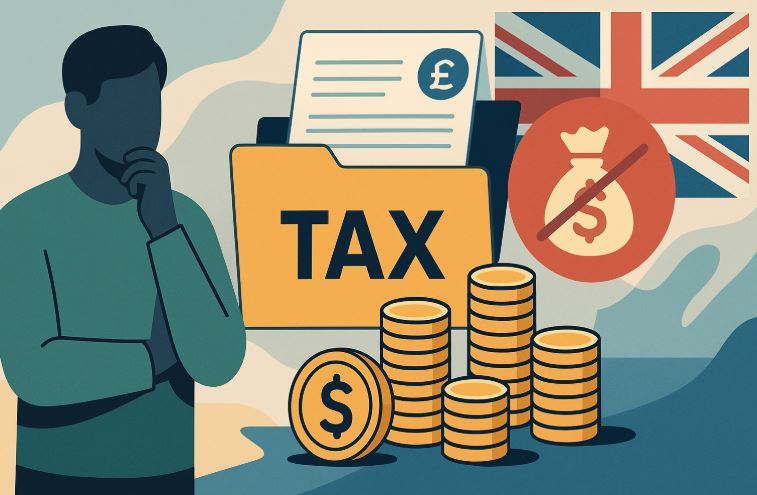Every year, billions of pounds fail to reach the UK government’s coffers, not because they were never owed, but because they were never paid.
This gap, often described as the “tax gap”, represents money lost through various means, including tax evasion, errors, legal disputes, and importantly, tax avoidance.
While some see tax avoidance as a ‘grey area’ of the law, the implications are far-reaching. It isn’t simply a legal technicality; it’s a practice that contributes directly to reduced funding for public services and weakened trust in the fairness of the system.
So, just how much does tax avoidance cost the UK each year? And how does it fit into the broader issue of tax compliance?
In this blog, we’ll explore the cost of tax avoidance in pounds and pence, who’s responsible, and what measures are being taken to stop it.
Why Is the Tax Gap Still Growing Despite Stronger Compliance Efforts?

The UK tax gap has persisted for decades despite numerous reforms, investigations, and enforcement strategies by HMRC.
According to the latest HMRC data, the estimated tax gap for 2021-2022 stood at £36 billion, which represents 4.8% of total expected tax revenue. While this figure has seen minor fluctuations year-on-year, the general trend shows that the problem is not going away.
Breakdown of Compliance Failures
A variety of factors contribute to the tax gap, including:
- Tax evasion
- Errors and failure to take reasonable care
- Legal interpretation disputes
- Criminal attacks on the tax system
- Tax avoidance
- Non-payment of taxes
- The hidden economy
Despite government investments in technology and personnel, such as the £1 billion funding boost from 2022 to 2025 for HMRC, the complexity and scale of the tax system leave many opportunities for money to slip through the cracks.
Why It Keeps Happening?
The persistence of the tax gap can be attributed to a few key challenges:
- Outdated laws and enforcement limitations
- Slow inter-agency collaboration, particularly between HMRC, Companies House, and the Insolvency Service
- Resource-intensive investigations that can take years to conclude
- A growing hidden economy powered by undeclared digital income
The Public Accounts Committee (PAC) has recently criticised HMRC’s lack of urgency and strategic clarity, warning that billions in lost taxes could be a severe underestimate. Clearly, current compliance efforts, while valuable, have yet to fully address the scale of the problem.
How Do Different Behaviours Contribute to the UK’s Tax Gap?
HMRC categorises the causes of the tax gap by taxpayer behaviour. These behaviours provide insight into the underlying reasons why tax goes unpaid.
According to the Measuring Tax Gaps 2025 report, the tax gap from 2023 to 2024 can be broken down by the following behavioural components:
| Behaviour | Share of Tax Gap (2023–2024) |
| Failure to take reasonable care | 31% |
| Error | 15% |
| Evasion | 14% |
| Legal interpretation | 12% |
| Criminal attacks | 9% |
| Non-payment | 12% |
| Hidden economy | 5% |
| Avoidance | 1% |
What This Means?
- Failure to take reasonable care is now the most significant contributor to the gap, highlighting the need for better taxpayer education and simplification of processes.
- Tax evasion, although often in the spotlight, accounts for a smaller portion than many might assume.
- Tax avoidance, while only 1%, still equates to a significant £0.7 billion in 2023-2024, a large amount in practical terms.
Despite only representing a small fraction, tax avoidance is particularly problematic because it often involves sophisticated legal manipulation, making it harder to combat than blatant evasion or fraud.
Who Are the Biggest Offenders in Tax Evasion and Avoidance?

It is tempting to picture tax dodging as the work of rogue billionaires or corrupt corporations, but HMRC data paints a more nuanced picture.
Tax Gap by Sector (2021–2022)
| Sector | Tax Gap Estimate |
| Small Businesses | £14.3 billion |
| Large Businesses | £6.1 billion |
| Criminals | £5.4 billion |
| Medium Businesses | £4.6 billion |
| Individuals | £2.6 billion |
Small businesses top the chart, contributing more to the tax gap than any other group. This could be due to:
- Lack of professional tax advice
- Complex VAT rules
- Cash-in-hand transactions
- Limited HMRC scrutiny
High-profile tax avoidance cases also reveal involvement from large corporations and wealthy individuals. For instance, Dominic Chappell, former owner of BHS, was jailed for six years for evading over half a million pounds in tax. Such cases reinforce that non-compliance exists at all levels.
What Is the Impact of Tax Avoidance on Public Services?
Tax avoidance might seem like a harmless game of legal loopholes to some, but the consequences for public services are serious. Every pound not collected in taxes is a pound not spent on essential services such as the NHS, schools, and infrastructure.
Consequences of Revenue Loss
- Longer NHS waiting times due to underfunding
- Cuts to local council budgets
- Under-resourced policing and justice systems
- Delays in transport infrastructure
The £0.7 billion lost annually to avoidance could fund thousands of nurses, new school facilities, or investment in green energy. Tax avoidance not only deprives the Treasury of funds, but also shifts the burden onto law-abiding citizens and smaller businesses that cannot afford complex tax strategies.
How Effective Has HMRC Been in Tackling Tax Evasion?
HMRC has made significant strides in recent years, especially through:
- Increased criminal investigations
- Expansion of the Connect system for identifying discrepancies
- Crackdowns on offshore accounts
However, from 2018-19 to 2023-24, prosecutions dropped from 749 to 344, and the number of directors disqualified for fraudulent business practices remained worryingly low.
Enforcement Challenges
The PAC has criticised HMRC for lacking curiosity and drive in tackling evasive behaviour. A key issue is the failure to act swiftly on fraudulent registrations, such as those using innocent individuals’ addresses for VAT scams.
These systemic weaknesses suggest a need for more integrated and forceful enforcement across government bodies.
Where Is Tax Being Lost Most — Individuals, Businesses or Criminals?

The tax gap does not fall evenly across society. Different sectors contribute to the gap in different ways.
Breakdown by Source (2021–2022)
| Source | Estimated Tax Lost |
| Income Tax, NICs, CGT | £12.4 billion |
| VAT | £7.9 billion |
| Corporation Tax | £5.1 billion |
| Excise Duties | £2.9 billion |
| Other Taxes | £1.7 billion |
This shows that personal and corporate tax gaps account for the majority of losses. Individuals and businesses alike are implicated, whether through undeclared side jobs or creative accounting.
Is HMRC Underestimating the Real Cost of Tax Evasion?
According to the PAC, HMRC’s official estimate of £5.5 billion lost to evasion in 2022-23 could be a significant underestimate. In fact, the scale of fraudulent activity, especially among small businesses and online sellers, might be much larger than recorded.
Key Findings from PAC Report
- Up to 20% of UK-registered companies in 2023 could be fraudulent
- HMRC lacks a cohesive strategy to investigate and close these gaps
- VAT scams using false addresses remain unresolved
The introduction of the Economic Crime and Corporate Transparency Act 2023 is a positive step, granting Companies House greater powers. But its effectiveness will depend on how well agencies work together to identify fraud.
Are Current Tax Laws Strong Enough to Prevent Avoidance?
The nature of tax avoidance lies in its exploitation of legal loopholes. While the letter of the law is followed, the spirit is often ignored. This presents a real challenge for lawmakers.
Legal Loopholes and Aggressive Planning
Avoidance strategies often involve:
- Using offshore jurisdictions
- Re-characterising income as capital gains
- Exploiting timing differences in accounting
Despite various anti-avoidance rules and the General Anti-Abuse Rule (GAAR), many avoidance schemes still operate within grey areas.
Need for Reform
There is a growing call for:
- Clearer tax legislation
- Stricter penalties for promoters of avoidance schemes
- Faster legislative response to emerging schemes
How Are Offshore Tax Schemes Impacting UK Revenue?

Since 2010, the UK government has made a significant effort to address offshore tax evasion, recovering over £3.2 billion through investigations. But offshore schemes remain a stubborn problem.
Challenges of Offshore Evasion
- Difficulty in accessing foreign banking records
- Use of trusts and shell companies
- Jurisdictional secrecy
The government has invested £2.8 billion since 2010 into this area, but complex international arrangements mean recovery is slow and incomplete.
What Role Will New Legislation Play in Closing the Tax Gap?
The Economic Crime and Corporate Transparency Act 2023 introduces several changes aimed at strengthening the system:
- Companies House now has power to remove fraudulent company records
- Mandatory identity verification will roll out in 2025
- Aim to combat phoenixism and shell companies
However, the PAC warns that unless these powers are fully enforced, and unless agencies such as HMRC use them proactively, the tax gap will continue to undermine economic fairness.
Conclusion
Tax avoidance may represent a smaller percentage of the UK’s overall tax gap, but its impact is far from minor. The £0.7 billion lost annually to avoidance, combined with billions more lost to evasion and errors, highlights a pressing need for reform.
Whether it’s increasing transparency, tightening legislation, or holding major offenders accountable, a cohesive, strategic approach is long overdue.
Government agencies must work together, enforce existing powers, and act with urgency. Only then can we hope to narrow the tax gap and ensure that everyone contributes their fair share.
FAQs
What is the difference between tax avoidance and tax evasion?
Tax avoidance involves legally minimising tax using loopholes, while tax evasion is illegal and involves deliberately hiding income or falsifying records.
How much is lost to tax avoidance annually in the UK?
According to HMRC’s 2025 report, tax avoidance cost the UK around £0.7 billion in 2023-24.
Why do small businesses contribute the most to the tax gap?
Many small businesses lack access to professional tax advice, making them more susceptible to errors, evasion, or unintentional non-compliance.
What steps is HMRC taking to reduce the tax gap?
HMRC is increasing funding, using digital tools like the Connect system, and launching more targeted investigations.
Are offshore tax avoidance schemes still a problem?
Yes, despite improvements, offshore tax avoidance remains an issue due to secrecy laws and complex corporate structures.
Has the new legislation improved tax compliance?
The Economic Crime and Corporate Transparency Act 2023 has potential, but its success depends on strong enforcement.
How can individuals avoid falling into tax evasion unintentionally?
Keeping accurate records, declaring all income including side jobs, and seeking professional advice can help stay compliant.









